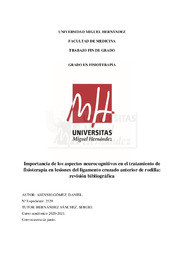Por favor, use este identificador para citar o enlazar este ítem:
https://hdl.handle.net/11000/25694Registro completo de metadatos
| Campo DC | Valor | Lengua/Idioma |
|---|---|---|
| dc.contributor.advisor | Hernández Sánchez, Sergio | - |
| dc.contributor.author | Asensio Gómez, Daniel | - |
| dc.contributor.other | Departamentos de la UMH::Patología y Cirugía | es_ES |
| dc.date.accessioned | 2022-01-14T10:52:13Z | - |
| dc.date.available | 2022-01-14T10:52:13Z | - |
| dc.date.created | 2021-06-20 | - |
| dc.date.issued | 2021-06-20 | - |
| dc.identifier.uri | http://hdl.handle.net/11000/25694 | - |
| dc.description.abstract | Introducción: el ligamento cruzado anterior (LCA) es el encargado de proporcionar estabilidad mecánica y función sensorial a la articulación de la rodilla. Tras esta lesión, la función sensorial se ve afectada por la pérdida de mecanorreceptores, especialmente tras la intervención quirúrgica. Esta patología ya no se considera una lesión musculoesquelética periférica o mecánica, sino una disfunción neurofisiológica que afecta a la organización del sistema nervioso central (SNC). Este cambio de paradigma debería contemplarse en el proceso de rehabilitación, evitando así el alto índice de recaídas. Objetivos: revisar los efectos sensoriomotores de intervenciones terapéuticas o preventivas sobre el LCA que incluyan un abordaje neurocognitivo, así como describir sus cambios centrales, características y beneficios, junto a una serie de recomendaciones clínicas. Material y métodos: búsqueda bibliográfica de estudios publicados a partir de 2010 que abordasen las implicaciones neurocognitivas de la lesión de LCA en las bases de datos Pubmed, Scopus, ScienceDirect, Web of Science, Cochrane y PEDro. Resultados: se incluyeron nueve estudios. Cuatro analizan los cambios sensoriomotores centrales mediante resonancia magnética tras la lesión de LCA, cuatro analizaron diferentes pruebas de salto con la adición de componente neurocognitivo y uno comparó una rehabilitación neurocognitiva frente a una tradicional. Conclusiones: se encontró evidencia de los cambios sensoriomotores de pacientes con rotura de LCA, de pacientes sanos que podrían sufrir esta lesión y de los beneficios de la rehabilitación neurocognitiva, mostrándose una serie de recomendaciones. Sin embargo, debido a la escasez de estudios disponibles, se necesita mayor cantidad y calidad de investigación. | es_ES |
| dc.description.abstract | Introduction: the anterior cruciate ligament (ACL) is in charge of providing mechanical stability and sensory function to the knee joint. After this injury, sensory function is affected by the loss of mechanoreceptors, especially after surgery. This pathology is no longer considered a peripheral or mechanical musculoskeletal injury, but a neurophysiological dysfunction that affects the organization of the central nervous system (CNS). This paradigm shift should be considered in the rehabilitation process, thus avoiding the high relapse rate. Objectives: to review the sensorimotor effects of therapeutic or preventive interventions on ACL that include a neurocognitive approach, as well as to describe its central changes, characteristics and benefits, together with a series of clinical recommendations. Material and methods: literature search of studies published since 2010 that addressed the neurocognitive implications of ACL injury in the Pubmed, Scopus, ScienceDirect, Web of Science, Cochrane and PEDro databases. Results: nine studies were included. Four analyze the central sensorimotor changes using magnetic resonance imaging (MRI) after ACL injury, four analyzed different jumping tests with the addition of a neurocognitive component, and one compared a neurocognitive rehabilitation with a traditional one. Conclusions: evidence was found of sensorimotor changes in patients with ACL tear, in healthy patients who could suffer this injury and the benefits of neurocognitive rehabilitation, showing a series of recommendations. However, due to the paucity of available studies, a greater quantity and quality of research is needed. | es_ES |
| dc.format | application/pdf | es_ES |
| dc.format.extent | 34 | es_ES |
| dc.language.iso | spa | es_ES |
| dc.publisher | Universidad Miguel Hernández de Elche | es_ES |
| dc.rights | info:eu-repo/semantics/openAccess | es_ES |
| dc.rights.uri | http://creativecommons.org/licenses/by-nc-nd/4.0/ | * |
| dc.subject | Rehabilitación LCA | es_ES |
| dc.subject | Reconstrucción LCA | es_ES |
| dc.subject | Neuroplasticidad | es_ES |
| dc.subject | Cambios sensoriomotores | es_ES |
| dc.subject | ACL rehabilitation | es_ES |
| dc.subject | ACL reconstruction | es_ES |
| dc.subject | Neuroplasticity | es_ES |
| dc.subject | Sensorimotor changes | es_ES |
| dc.subject.other | CDU::6 - Ciencias aplicadas | es_ES |
| dc.title | Importancia de los aspectos neurocognitivos en el tratamiento de fisioterapia en lesiones del ligamento cruzado anterior de rodilla: revisión bibliográfica | es_ES |
| dc.type | info:eu-repo/semantics/bachelorThesis | es_ES |

Ver/Abrir:
ASENSIO GÓMEZ, DANIEL. Importancia de los aspectos neurocognitivos en el tratamiento de fisioterapia en lesiones del ligamento cruzado anterior de rodilla. Revisión bibliográfica.pdf
1,56 MB
Adobe PDF
Compartir:
 La licencia se describe como: Atribución-NonComercial-NoDerivada 4.0 Internacional.
La licencia se describe como: Atribución-NonComercial-NoDerivada 4.0 Internacional.
.png)